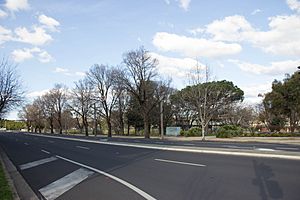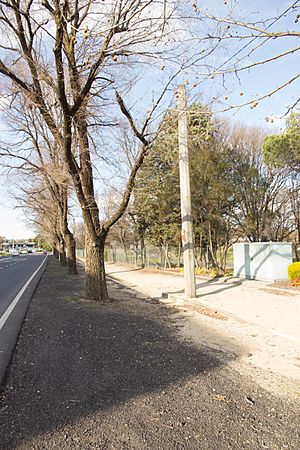Bentinck Street Elm Trees facts for kids
Quick facts for kids Bentinck Street Elm Trees |
|
|---|---|

Bentinck Street elm trees, pictured in late winter 2018.
|
|
| Location | Bentinck Street, Bathurst, Bathurst Region, New South Wales, Australia |
| Owner | Bathurst Regional Council |
| Official name: Bentinck Street Elm Trees | |
| Type | state heritage (landscape) |
| Designated | 2 April 1999 |
| Reference no. | 369 |
| Type | Tree groups - street |
| Category | Parks, Gardens and Trees |
| Lua error in Module:Location_map at line 420: attempt to index field 'wikibase' (a nil value). | |
The Bentinck Street Elm Trees are a special group of old trees in Bentinck Street, Bathurst, Australia. These trees are very important because they are part of the area's history and beauty. They are protected as a heritage site by the New South Wales State Heritage Register. The trees are owned by the Bathurst Regional Council.
Contents
History of the Elm Trees
The elm trees on Bentinck Street were planted around 1904. They were later "pollarded," which means their upper branches were cut back. This helps the trees grow new, dense branches.
English elms were very popular trees to plant between about 1880 and 1920. This time is known as the "Federation era" in Australia. Many towns in inland New South Wales, like Bathurst, Albury, and Orange, planted elms during this period. They were a favourite choice for street trees. You can still see beautiful, old English elms in important parks in Bathurst, like Machattie Park.
It's interesting that both Bathurst and Goulburn, two of the first major inland cities in New South Wales, have many old elm trees in their downtown areas.
Protecting the Trees
In 1984, there was a plan to make Bentinck Street wider for more traffic. This plan would have meant cutting down 20 of the elm trees. A group called the Bathurst Action Committee to Secure Unified Planning (BACSUP) contacted the Heritage Council to try and save the trees.
After many talks and meetings, the Heritage Council decided the trees were too important to remove. They had historical value and made the street look special. On 22 August 1994, a special order was put in place to protect 16 of the trees.
The Heritage Council worked with Bathurst Council to find other ways to improve the road without harming the trees. They even hired an expert to help. On 14 September 1984, a temporary protection order was put on the trees.
Later, some people asked to remove or trim the trees. The Heritage Council allowed some trimming and approved cutting back branches to a certain height. However, they decided it was very important to protect the trees for the future.
On 6 December 1984, the Heritage Council suggested a permanent protection order for the 16 elm trees. This order was officially put in place on 16 August 1985. The trees were then added to the State Heritage Register on 2 April 1999. This means they are now officially recognised as a very important part of New South Wales's heritage.
What the Trees Look Like
The Bentinck Street English elms are a type of tree called Ulmus procera. They form a healthy row of trees that are all about the same size. They grow to be about 9 to 12 metres tall.
English elms are often planted in parks and large gardens because they are very beautiful. They are deciduous, which means they lose their leaves in autumn. There are 13 of these elm trees on the eastern side of Bentinck Street and 3 on the western side. They are located between Howick and Durham Streets.
Why They Are Heritage Listed
The old English elm trees on Bentinck Street were planted around 1900. They are considered very important because they add a lot to the historical look of Bathurst. Being "heritage-listed" means they are officially recognised as a significant part of the area's history and culture.
The Bentinck Street Elm Trees were added to the New South Wales State Heritage Register on 2 April 1999.


